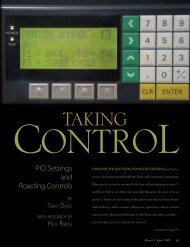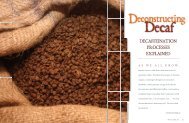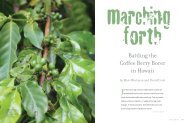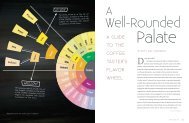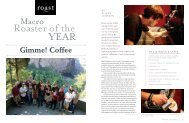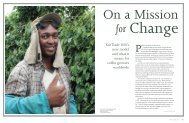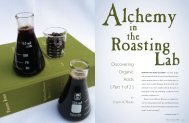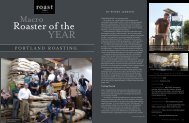to download a low resolution preview of this article - Roast Magazine
to download a low resolution preview of this article - Roast Magazine
to download a low resolution preview of this article - Roast Magazine
Create successful ePaper yourself
Turn your PDF publications into a flip-book with our unique Google optimized e-Paper software.
Laying It<br />
on the<br />
Table<br />
A Look at<br />
the State <strong>of</strong> Cupping<br />
by Andi C. Trindle Mersch<br />
As I said in the first half <strong>of</strong> <strong>this</strong> two-part “state <strong>of</strong> the c<strong>of</strong>fee<br />
industry” series, “when you’ve been doing something for<br />
a while, you become compelled <strong>to</strong> step back and take a<br />
look <strong>to</strong> make sure you’re doing something worthwhile and that you’re<br />
doing it the right way.” This sentiment is especially true if you’re<br />
a perfectionist. Although I have grudgingly abandoned the idea <strong>of</strong><br />
achieving self-perfection, I seem <strong>to</strong> still expect it <strong>of</strong> systems: iPhones,<br />
computers, cable TV—and cupping. C<strong>of</strong>fee cupping—as our industry’s<br />
formal and, thus far, only universally agreed-upon sensory qualityassessment<br />
<strong>to</strong>ol that has very real financial implications—is a system<br />
that should be perfect. Right?<br />
By all accounts the industry has come a long way over the years,<br />
but perfection in cupping is probably as likely as perfection in me. As<br />
an industry, we may need <strong>to</strong> pursue the next evolution <strong>of</strong> cupping and,<br />
at the very least, we need some reflection and realignment.<br />
continued on page 26<br />
pho<strong>to</strong> courtesy <strong>of</strong> Fonté C<strong>of</strong>fee<br />
24 roast September | Oc<strong>to</strong>ber 2012 25
Laying It on the Table | Cupping (continued)<br />
Why We Cup<br />
Before we dig in<strong>to</strong> some <strong>of</strong> the reasons for re-evaluation <strong>of</strong> the<br />
cupping process, let’s look at some <strong>of</strong> the reasons why we cup in<br />
the first place. According <strong>to</strong> the Specialty C<strong>of</strong>fee Association <strong>of</strong><br />
America’s cupping curriculum, we cup c<strong>of</strong>fees for the fol<strong>low</strong>ing<br />
reasons:<br />
• Purchasing<br />
• Quality and price discovery<br />
• Subject <strong>to</strong> Approval <strong>of</strong> Sample (SAS) applications<br />
• Quality assurance (incorporating roast pr<strong>of</strong>iling, as well as<br />
consistency moni<strong>to</strong>ring)<br />
• Blending<br />
• Palate enrichment<br />
• Education/training<br />
These are some valuable motivations—particularly those<br />
that influence which c<strong>of</strong>fees are bought and sold and at what<br />
prices. And, as Brian Aliffi, green c<strong>of</strong>fee sourcing manager at<br />
Minnesota-based Caribou C<strong>of</strong>fee, states, “Cupping provides a<br />
simple <strong>to</strong>ol for evaluating multiple samples in a convenient<br />
time frame and with a minimum required sample size.”<br />
Without spending any more time acknowledging the value<br />
and need for cupping, we can probably all agree that we need <strong>to</strong><br />
have a formal, efficient system for evaluating c<strong>of</strong>fees. But …<br />
Is the Cupping<br />
Process Working?<br />
pho<strong>to</strong> by Chad Trewick<br />
Short answer: yes. More accurate answer: not wholly.<br />
As Martin Diedrich, founder <strong>of</strong> California-based Kean<br />
C<strong>of</strong>fee, says, “It’s so amazing <strong>to</strong> go <strong>to</strong> origin and be able <strong>to</strong><br />
speak the same language.” This simple statement reflects<br />
what’s generally working with cupping. We have developed<br />
an industry language that al<strong>low</strong>s us <strong>to</strong> understand each other<br />
across borders. This language <strong>of</strong> ours includes vocabulary and<br />
numbers—i.e., descrip<strong>to</strong>rs and scores—which theoretically<br />
help us agree on an objective c<strong>of</strong>fee quality. From here, we can<br />
make informed buying and selling decisions that al<strong>low</strong> our<br />
businesses <strong>to</strong> succeed while, in turn, securing the growth <strong>of</strong><br />
specialty within the greater c<strong>of</strong>fee industry.<br />
Getting back <strong>to</strong> the longer and more realistic answer <strong>of</strong> “not<br />
wholly,” however, imperfections <strong>of</strong> the cupping process are<br />
many—from pro<strong>to</strong>cols <strong>to</strong> calibration <strong>to</strong> bias.<br />
Pro<strong>to</strong>cols<br />
“Pro<strong>to</strong>cols” is the term generally adopted within our industry<br />
<strong>to</strong> identify the best practice/industry guidelines for preparing<br />
a formal cupping. Pro<strong>to</strong>cols for consistency in roast degree,<br />
steeping time, grind degree, water quality and temperature,<br />
lighting, and many other fac<strong>to</strong>rs exist <strong>to</strong> ensure that a cupping<br />
session is as scientific as possible, thereby yielding (in theory)<br />
objective results. Because c<strong>of</strong>fee tasting is inherently rife with<br />
uncontrollable variables, such as the differences between tasters<br />
(taste buds, taste experience, psychology and physiology <strong>to</strong> name<br />
a few), it’s particularly important <strong>to</strong> identify and systematically<br />
manage these controllable variables.<br />
The SCAA, Cup <strong>of</strong> Excellence and CQI training programs,<br />
among other programs and companies in the c<strong>of</strong>fee industry,<br />
have done an excellent job instilling cupping pro<strong>to</strong>cols around the<br />
globe in recent years. Although these organizations impart slight<br />
variation in pro<strong>to</strong>cols, they generally espouse similar guidelines,<br />
and all agree that consistent practices from session <strong>to</strong> session<br />
are critical. However, “in general, scientific practices are not<br />
consistently fol<strong>low</strong>ed in most cupping labs,” says K.C. O’Keefe,<br />
founder <strong>of</strong> Café Verde Peru, a c<strong>of</strong>feehouse in Lima, and the chair<br />
<strong>of</strong> the SCAA’s pr<strong>of</strong>essional cupper development committee. “This<br />
introduces unacceptable margin for errors in extraction and flavor<br />
development in the cup,” O’Keefe notes.<br />
continued on page 28<br />
26 roast September | Oc<strong>to</strong>ber 2012 27
Laying It on the Table | A Look at the State <strong>of</strong> Cupping (continued)<br />
Indeed, my own impetus for writing <strong>this</strong> <strong>article</strong> came from<br />
my frustrations owing <strong>to</strong> variant pro<strong>to</strong>cols in a lab setting. Earlier<br />
<strong>this</strong> year, I found myself participating in origin cuppings where<br />
some important, basic pro<strong>to</strong>cols weren’t fol<strong>low</strong>ed. The intention <strong>to</strong><br />
host a formal cupping was very clear, and these producers (unlike<br />
most around the globe) had appropriate equipment and the general<br />
setup for pr<strong>of</strong>essional cupping. (Credit must go <strong>to</strong> dedicated NGO,<br />
industry partners, and government organizations around the world<br />
for devotedly dispensing cupping<br />
training and supplies in recent<br />
decades.) Nonetheless, training and/<br />
or resources simply didn’t support<br />
meticulous analysis. In these cases,<br />
water temperature wasn’t moni<strong>to</strong>red,<br />
roast degrees between samples were<br />
wide, and cuppers did not rinse their<br />
spoons from cup <strong>to</strong> cup. There were<br />
more problems than these, but these<br />
particular inconsistencies stuck out as highly problematic. Could<br />
I really make an informed buying decision or even provide helpful<br />
commentary about c<strong>of</strong>fees where so many influential variables were<br />
uncontrolled? (Note: A buying decision on the ground at origin is<br />
separate from a final pre-shipment sample approval process.)<br />
I posit that many pr<strong>of</strong>essional<br />
c<strong>of</strong>fee buyers and sellers don’t<br />
maintain proper pro<strong>to</strong>cols 100<br />
percent <strong>of</strong> the time and some<br />
don’t even attempt them.<br />
To be clear, pro<strong>to</strong>col lapses are in no way limited <strong>to</strong> origin-side<br />
operations. I posit that many pr<strong>of</strong>essional c<strong>of</strong>fee buyers and sellers<br />
don’t maintain proper pro<strong>to</strong>cols 100 percent <strong>of</strong> the time and some<br />
don’t even attempt them.<br />
In addition, some question whether existing pro<strong>to</strong>cols are<br />
sufficient and wholly accurate. As one example, E<strong>to</strong>n Tsuno,<br />
direc<strong>to</strong>r <strong>of</strong> c<strong>of</strong>fee at Sacramen<strong>to</strong>’s Temple C<strong>of</strong>fee <strong>Roast</strong>ers, suggests<br />
that water pro<strong>to</strong>cols should be published in exact gram weight <strong>of</strong><br />
water in addition <strong>to</strong> traditional<br />
volume recommendations, since<br />
<strong>this</strong> echoes the current habits <strong>of</strong><br />
baristas in measuring and evaluating<br />
espresso and filter drip extractions.<br />
The quality <strong>of</strong> water is even more<br />
important as water comprises<br />
approximately 98.75 percent <strong>of</strong> the<br />
brewed beverage in a traditional<br />
cupping. Despite the importance <strong>of</strong><br />
water quality, however, labs around the world (and even within the<br />
United States) don’t use a standardized water base.<br />
For Chris<strong>to</strong>pher Schooley, a roaster who works with C<strong>of</strong>fee Shrub,<br />
a huge weakness <strong>of</strong> current cupping practice exists in the roast degree<br />
continued on page 30<br />
28 roast September | Oc<strong>to</strong>ber 2012 29
Laying It on the Table | A Look at the State <strong>of</strong> Cupping (continued)<br />
recommendation. “You have <strong>to</strong> look at more than one<br />
roast,” he says, because “there are problems with taking<br />
a qualitative measurement <strong>of</strong> both acidity and body, two<br />
things greatly influenced by roast development, unless you<br />
are looking at a couple <strong>of</strong> different roasts.”<br />
O’Keefe also feels that the sample-roasting<br />
specifications are <strong>to</strong>o lax and instead requires that his<br />
samples are “roasted within 10:30–11:15 [minutes] rather<br />
than the eight- <strong>to</strong> 12-minute window <strong>of</strong> the SCAA.”<br />
Certainly, there are many other conditions and<br />
variables in cupping that might be better controlled or<br />
differently managed. Without postulating conclusions<br />
here, I suggest <strong>to</strong> the industry that we review existing<br />
pro<strong>to</strong>cols and best practices <strong>to</strong> see where we can improve<br />
upon them in the interest <strong>of</strong> achieving greater objectivity<br />
and balance <strong>of</strong> results.<br />
Of course, until everyone is rigorously employing<br />
pro<strong>to</strong>cols, creating more <strong>of</strong> them or adapting them doesn’t<br />
fix anything.<br />
Calibration<br />
pho<strong>to</strong> by Chad Trewick<br />
Even if we had a perfect tasting process available <strong>to</strong> us<br />
and we employed its pro<strong>to</strong>cols religiously, a more difficult<br />
or does fruity mean cherry <strong>to</strong> some and over-fermented <strong>to</strong> others?<br />
challenge manifests in the concept <strong>of</strong> calibration. Calibration is<br />
Is an 85-point c<strong>of</strong>fee in one lab at least in the range <strong>of</strong> 84–86 among<br />
the notion that, assuming equality <strong>of</strong> sample and process, cuppers cuppers <strong>of</strong> the same c<strong>of</strong>fee elsewhere? For cupping <strong>to</strong> serve its critical<br />
around the world are consistently infusing vocabulary and scoring purpose as a buying and selling <strong>to</strong>ol and price determiner, we have <strong>to</strong><br />
with like meaning. Are the words citrus, fruity, savory and floral have semantic consensus among our pr<strong>of</strong>essional tasters. As Tsuno<br />
applied consistently among cuppers <strong>of</strong> the same c<strong>of</strong>fee, for example, states, “[Without calibration] pricing will break down, since in our<br />
small sec<strong>to</strong>r <strong>of</strong> c<strong>of</strong>fee, price should<br />
be in direct relation <strong>to</strong> quality/<br />
cupping score.” (Tsuno also suggests<br />
that “availability, sustainability and<br />
traceability” are part <strong>of</strong> the pricing<br />
equation.) If we aren’t speaking the<br />
same language, how do we determine<br />
fairly if a c<strong>of</strong>fee is worth a differential<br />
<strong>of</strong> +50 versus +250? And, are we doing<br />
ourselves a disservice by selling c<strong>of</strong>fees<br />
<strong>to</strong> consumers at prices they aren’t<br />
really worth?<br />
Over the years, I have frequently<br />
questioned whether we are universally<br />
calibrated as tasters. For example,<br />
many times, I have been witness <strong>to</strong> or<br />
part <strong>of</strong> debates over whether a “fruity”<br />
sample (in the same cupping session)<br />
is over-fermented and defective or<br />
whether it is a 90-plus-rated c<strong>of</strong>fee.<br />
Well-respected and experienced tasters<br />
can land on opposite sides <strong>of</strong> <strong>this</strong><br />
debate.<br />
continued on page 32<br />
pho<strong>to</strong> by Chad Trewick<br />
30 roast September | Oc<strong>to</strong>ber 2012 31
Laying It on the Table | A Look at the State <strong>of</strong> Cupping (continued)<br />
Tsuno, having also experienced <strong>this</strong><br />
both controlled and uncontrolled—<strong>to</strong><br />
later in the <strong>article</strong>), but some <strong>of</strong> it is<br />
but who is right in these scenarios, and<br />
a generally poor reputation for quality.<br />
a deserved 88. Or, sometimes, because we<br />
particular argument, states, “I believe many<br />
find some objective end <strong>to</strong> these debates.<br />
because we don’t have universal language<br />
can there even be a “right” score? After<br />
Similarly, if a well-known industry taster<br />
feel that everyone else—a COE jury panel or<br />
people need more training in identifying<br />
However, even if we can come <strong>to</strong> agreement<br />
agreement.<br />
all, cultural consumer preferences are<br />
has scored a c<strong>of</strong>fee highly, then others may<br />
a group <strong>of</strong> vocal roasters, for example—are<br />
uncontrolled ferment as a defect since what<br />
and can taste accurately whether fruit is<br />
Despite the frequency <strong>of</strong> these debates<br />
distinctly different and one community’s<br />
trend their own scoring on the high side.<br />
overrating a particular c<strong>of</strong>fee, we are more<br />
we like about honeys and naturals is a result<br />
caused by happenstance versus deliberate<br />
over the years, <strong>to</strong> my pleasant surprise<br />
“good” is another community’s<br />
And, <strong>of</strong> course, the reverse is true as<br />
critical <strong>of</strong> it in an effort <strong>to</strong> assert our non-<br />
in controlled ferment.” Tsuno is exactly<br />
effort in processing, I suspect we will still<br />
when I questioned some fel<strong>low</strong> tasters<br />
“outstanding,” which warrant very<br />
well. A sample might be very good, but,<br />
bias. Al<strong>low</strong>ing these influences <strong>to</strong> impact our<br />
right: as an industry, we need more training<br />
have variation on what is “positive” fruit<br />
about calibration, they were largely<br />
different scores. Still, with purchasing<br />
because a cupper is disinclined <strong>to</strong> believe it<br />
evaluation is, <strong>of</strong> course, unpr<strong>of</strong>essional, and<br />
<strong>to</strong> calibrate. In <strong>this</strong> particular case, we need<br />
versus fruit that is “defective.” Some <strong>of</strong> these<br />
positive about their success in matching<br />
decisions and price points at stake,<br />
based on past experience, they score more<br />
we’d all like <strong>to</strong> believe we do not al<strong>low</strong> them.<br />
more training <strong>of</strong> processing manifestations—<br />
issues get in<strong>to</strong> bias (which we will discuss<br />
their results with their outside partners.<br />
For Aliffi, Caribou finds that they “trend<br />
calibration has merit.<br />
The good news is that some level <strong>of</strong><br />
conservatively, awarding it an 85 score versus<br />
continued on page 34<br />
in the same direction as our industry<br />
calibration among knowledgeable and<br />
contemporaries” more <strong>of</strong>ten than not.<br />
practiced tasters can happen. Tsuno<br />
O’Keefe asserted that his industry partners<br />
advises that “one should learn pro<strong>to</strong>col<br />
“consistently score/calibrate within<br />
from an industry pr<strong>of</strong>essional, and<br />
our results,” but he also acknowledges<br />
constantly review and communicate<br />
that they have some trading partners<br />
scores with other cuppers.” In particular <strong>to</strong><br />
whose “results are very inconsistent.”<br />
scoring calibration, he suggests cupping<br />
For O’Keefe, these inconsistencies are<br />
“true commercial, 60- <strong>to</strong> 70-point c<strong>of</strong>fees<br />
attributable <strong>to</strong> “counterparts neither<br />
and 90-plus-point c<strong>of</strong>fees in order <strong>to</strong> put<br />
scientifically running the lab, nor<br />
80-point c<strong>of</strong>fees in<strong>to</strong> relation.” (Although<br />
consistently cupping,” though, and<br />
we have many discrepancies when looking<br />
not problems <strong>of</strong> semantic variation.<br />
at smaller score ranges, we are calibrated<br />
Aliffi also says that “for calibration the<br />
enough as an industry that <strong>this</strong> 10-point-<br />
greatest challenge is practices in the<br />
range categorization is generally agreed<br />
lab.” Without doubt, poor pro<strong>to</strong>cols yield<br />
upon and, therefore, a tasting can be<br />
result variation, but part <strong>of</strong> the problem is<br />
organized effectively.)<br />
semantic. We are not speaking the same<br />
For Caribou, Aliffi suggests that<br />
language—both in words and numbers.<br />
continued exposure <strong>to</strong> events through<br />
Scoring certainly shows itself <strong>to</strong> be<br />
the SCAA and around the industry—the<br />
widely varied among different tasters and<br />
likes <strong>of</strong> barista competitions, C<strong>of</strong>fees<br />
different groups <strong>of</strong> tasters. Obviously,<br />
<strong>of</strong> the Year judging, COE events and<br />
exact score matching isn’t possible or even<br />
Rainforest Alliance cuppings—“has<br />
ideal, but it seems important that we<br />
rounded our abilities and helped us<br />
are generally in agreement with a fairly<br />
develop and maintain our consistency.”<br />
narrow range <strong>of</strong>, say, two <strong>to</strong> three points<br />
O’Keefe echoes COE participation as an<br />
as a two- <strong>to</strong> three-point variation can<br />
important calibration <strong>to</strong>ol, in addition <strong>to</strong><br />
put a c<strong>of</strong>fee in<strong>to</strong> a different quality and<br />
“honest, open sharing <strong>of</strong> blind cupping<br />
corresponding price categorization.<br />
scoring/categorization with your trading<br />
This group score just manifested itself<br />
partners.”<br />
in our <strong>of</strong>fice as we hosted a tasting <strong>of</strong> the<br />
Nicaragua Cup <strong>of</strong> Excellence (COE) c<strong>of</strong>fees.<br />
Generally speaking, the entire group <strong>of</strong><br />
Bias<br />
more than 12 outside tasters, plus our<br />
four cuppers, ranked the various lots with<br />
scores ranging from 82 <strong>to</strong> 90 and generally<br />
a solid few points (or more) <strong>low</strong>er than the<br />
COE jury panel across the board (all jury<br />
scores were above 85). Pro<strong>to</strong>col variation<br />
like roast degree might very well have<br />
been different and the influence <strong>of</strong> time<br />
between the jurors’ evaluation and ours<br />
was likely impactful (as an agricultural<br />
product, green c<strong>of</strong>fee’s properties will<br />
change over time regardless <strong>of</strong> sample<br />
preparation and evaluation methodology),<br />
One <strong>of</strong> the most prevalent problems with<br />
the cupping process is the influence <strong>of</strong><br />
bias. Fortunately, many biases are readily<br />
apparent and relatively easily mitigated.<br />
For example, if a cupper knows that a<br />
particular sample is from a producer who<br />
pays scrupulous attention <strong>to</strong> quality or<br />
from a farm with an excellent reputation,<br />
they may be inclined, without conscious<br />
awareness, <strong>to</strong> score it higher than they<br />
would score a c<strong>of</strong>fee coming from an<br />
unknown farm or from an origin with<br />
32 roast September | Oc<strong>to</strong>ber 2012 33
Laying It on the Table | A Look at the State <strong>of</strong> Cupping (continued)<br />
However, even among experienced tasters,<br />
these biases can occur despite best intentions<br />
and firm belief that we are in control <strong>of</strong><br />
our partialities. Human psychology is very<br />
powerful.<br />
So, cup blind. This simply means, cup<br />
without knowing what you’re cupping. Have<br />
someone else set up your tasting sessions<br />
ideally using codes only and don’t even try <strong>to</strong><br />
figure out or guess what you may be tasting.<br />
Just taste and evaluate honestly and with<br />
focus. Blind cupping isn’t always possible or<br />
practical, and sometimes there are distinct<br />
advantages <strong>to</strong> cupping with knowledge <strong>of</strong><br />
what you are tasting—calibration training,<br />
for example. Nonetheless, as participants in a<br />
process with results that impact pricing paid<br />
<strong>to</strong> farmers and feedback that can influence<br />
their future care <strong>of</strong> their beans, we should<br />
control the controllable variables.<br />
The Next Phase<br />
Ultimately, I feel that the cupping process<br />
is a worthwhile and important one, but<br />
it’s a process fraught with imperfections;<br />
the current cupping process will never<br />
achieve true objectivity. Of course, we<br />
don’t necessarily need complete objectivity;<br />
there are cultural preferences and biases<br />
that create a need for subjective variety in<br />
the marketplace. The key as pr<strong>of</strong>essionals,<br />
however, is in having a system with as much<br />
impartiality as possible. As specialty c<strong>of</strong>fee<br />
tasters, it can be easy <strong>to</strong> think <strong>of</strong> our job<br />
as just choosing the very best c<strong>of</strong>fees from<br />
around the world <strong>to</strong> showcase, but we should<br />
remember that our decisions at the cupping<br />
table have real financial implications for<br />
hard-working c<strong>of</strong>fee producers around the<br />
globe. So, knowing the limitations <strong>of</strong> the<br />
cupping process, as Schooley recommends, “it<br />
would be considerably helpful for [buyers] <strong>to</strong><br />
look at c<strong>of</strong>fees a couple <strong>of</strong> different times and<br />
in different iterations before making a final<br />
judgment.” Maybe we can all agree <strong>to</strong> do at<br />
least that while we re-evaluate and improve<br />
cupping evaluation in the long run.<br />
Andi C. Trindle Mersch is a green<br />
c<strong>of</strong>fee trader with Atlantic Specialty C<strong>of</strong>fee, Inc. in<br />
California, where she also runs the quality-control lab.<br />
She has been working in specialty c<strong>of</strong>fee since 1989. Andi<br />
has volunteered with the SCAA Training Committee since<br />
1995 and joined the board <strong>of</strong> direc<strong>to</strong>rs in March 2010. She<br />
can be reached at atrindle@ecomtrading.com.<br />
pho<strong>to</strong> by Chad Trewick<br />
34 roast September | Oc<strong>to</strong>ber 2012 35



